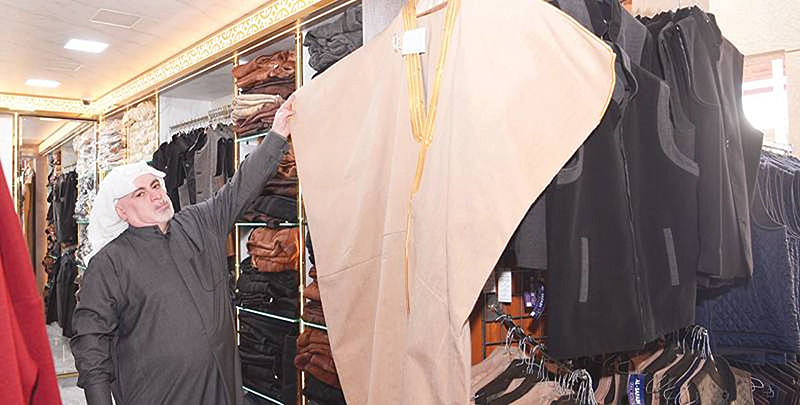21/01/2020
21/01/2020

KUWAIT CITY, Jan 20: “Bisht” (cloak) has been associated with dignity and veneration, and it remains an integral part of the originality of the past children inherited from grandparents, in terms of wearing, weaving or sewing it, reports Al-Qabas daily.
Wearing of bisht and its trade is still linked to the Kuwaiti heritage, which no one dispenses on occasions, whether in ceremonies, solace or even public occasions. It is equally a traditional dress famous to the Arabian Peninsula. During a tour of the market, it became clear to Al-Qabas that bisht are in different kinds and categories.
They come in different categories; including Japanese, Najafiand Lama. The price of bisht ranges between 60 and 1,200 dinars, while those with special specifications could be sold for 2,000 dinars, although the price depends on the type of material and method of sewing it.
Kuwaiti heritage
According to a tailor named Ali Abu Yousef who has been a professional bisht maker for 27 years, bisht is the complementary dress for Arab men and it’s considered a Kuwaiti heritage that still resists modernity with its beloved audience from Kuwait and the Arab Gulf states.
Abu Yusuf stated that the higher the quality of bisht, the higher the price, and it differs in terms of type and price. He explained that the type of raw material, method of spinning, quality of weaving, place of manufacture and thread used are among the authentic factors in determining its value. He indicated the design of bisht has not changed but additions have been made to the original, such as the color of embroidery and engravings to meet the tastes of buyers, especially the young ones. He listed three types of bisht for the seasons: summer, winter and spring, noting that Japanese, Najafiand French materials are used for summer bisht, while Japanese and Iranian materials are used for spring, because they are both warm.
Abu Yusuf pointed out that lamas’ hair is used in making winter bisht and it is sewn in two types. It is either with a broken prism or broken button. He explained the term “button” as the golden lines in the bisht, noting Kuwaiti bisht differs from other Gulf countries’ in the manner of sewing, indicating it is medium in size with plain colors and does not scrub in the buttons.
Talking about the size of its trade in Kuwait, it was reported as being medium. He explained that stitching of bisht varies from one country to another but the labor force in Kuwait is accurate. He declared the most expensive bisht is the Kashmiri Lint, followed by Iranian Bushahri Lint, while the price of Iranian Bisht reaches 600 dinars.


